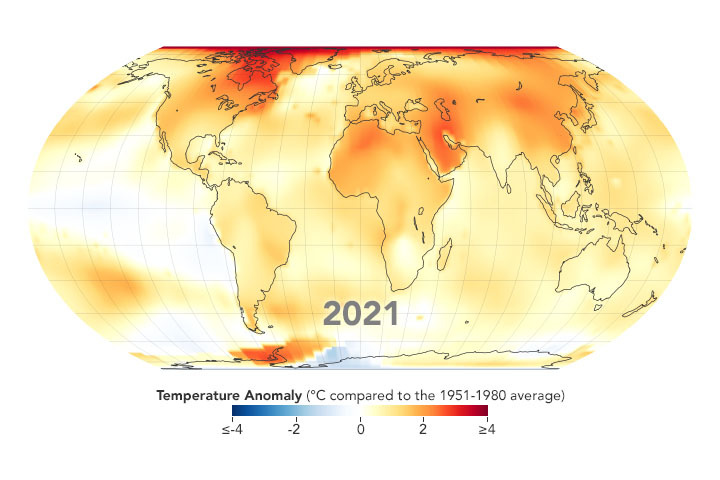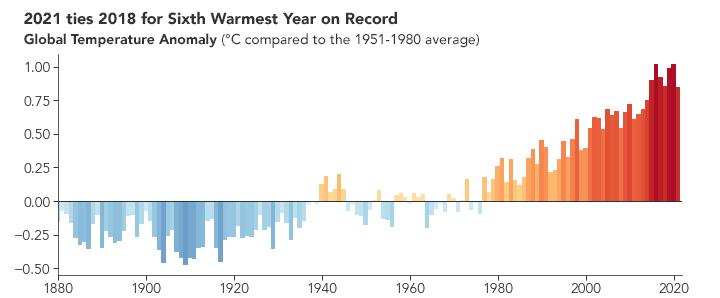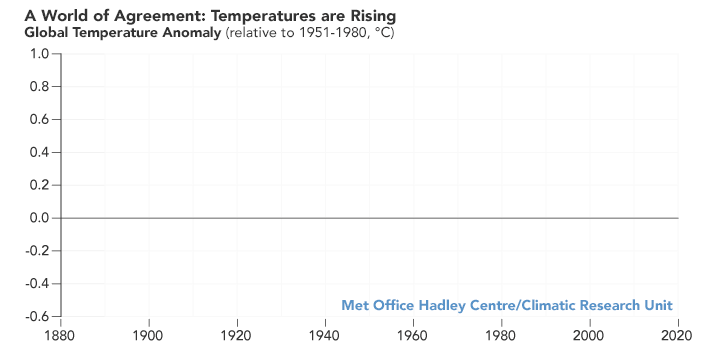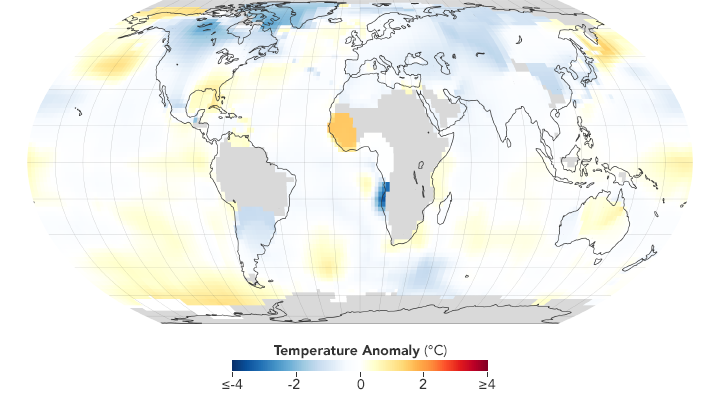After Reading 1.4 and 1.5, Does the Atmosphere/mood of 1.2 and 1.3 Seem Different? Explain
Air temperatures on Earth have been rising since the Industrial Revolution. While natural variability plays some role, the preponderance of evidence indicates that man activities—particularly emissions of oestrus-trapping greenhouse gases—are generally responsible for making our planet warmer.
According to an ongoing temperature analysis led by scientists at NASA's Goddard Plant for Space Studies (GISS), the average global temperature on World has increased past at to the lowest degree one.one° Celsius (1.9° Fahrenheit) since 1880. The bulk of the warming has occurred since 1975, at a rate of roughly 0.15 to 0.20°C per decade.
The maps above evidence temperature anomalies in five-year increments since 1880. (Click on the arrow to run the blitheness.) These are not absolute temperatures, just changes from the norm for each expanse. The data reflect how much warmer or cooler each region was compared to a base menstruum of 1951-1980. (The global mean surface air temperature for that period was 14°C (57°F), with an uncertainty of several tenths of a degree.)
The image below shows global temperature anomalies in 2021, the sixth warmest year on tape. Nine of the ten hottest years or record have occurred in the by decade.

As the maps testify, global warming does non hateful temperatures rise everywhere at every time past same rate. Temperatures might rise 5 degrees in one region and drop 2 degrees in another. For instance, uncommonly common cold winters in i identify might exist balanced by extremely warm winters in some other part of the world. Mostly, warming is greater over country than over the oceans because water is slower to absorb and release heat (thermal inertia). Warming may likewise differ substantially within specific land masses and ocean basins.
In the animation at the height of the page and in the bar chart beneath, the years from 1880 to 1939 tend to be libation, then level off past the 1950s. Decades within the base period (1951-1980) exercise not appear specially warm or cold because they are the standard against which other years are measured.
The leveling off of temperatures in the middle of the 20th century can exist explained by natural variability and by the cooling effects of aerosols generated past factories, power plants, and motor vehicles in the years of rapid economic growth afterwards World War II. Fossil fuel use also increased after the war (5 percentage per year), boosting greenhouse gases. Cooling from aerosol pollution happened quickly. In contrast, greenhouse gases accumulated slowly, just they remain in the atmosphere for a much longer fourth dimension. According to erstwhile GISS manager James Hansen, the potent warming tendency of the past four decades likely reflects a shift from counterbalanced aerosol and greenhouse gas furnishings on the temper to a predominance of greenhouse gas effects after aerosols were curbed by pollution controls.

Why should we intendance about one or two degrees of global warming? Later all, temperatures fluctuate by many degrees every day where we live.
The temperatures we experience locally and in brusk periods can fluctuate significantly due to predictable, cyclical events (night and day, summer and winter) and difficult-to-predict wind and precipitation patterns. But the global temperature mainly depends on how much free energy the planet receives from the Dominicus and how much it radiates dorsum into space. The energy coming from the Sun fluctuates very little by year, while the corporeality of free energy radiated past World is closely tied to the chemical composition of the atmosphere—particularly the amount of estrus-trapping greenhouse gases.
A one-degree global change is meaning because it takes a vast amount of oestrus to warm all of the oceans, the atmosphere, and the land masses by that much. In the past, a i- to two-degree drop was all it took to plunge the Globe into the Footling Ice Age. A v-degree drop was enough to bury a big office of North America under a towering mass of water ice xx,000 years ago.

Global temperature records start effectually 1880 because observations did not sufficiently embrace enough of the planet prior to that time. The line plot above shows yearly temperature anomalies from 1880 to 2020 as recorded past NASA, NOAA, the Berkeley Earth research group, the Met Office Hadley Heart (United Kingdom), and the Cowtan and Way analysis. Though at that place are minor variations from yr to year, all five records show peaks and valleys in sync with each other. All bear witness rapid warming in the past few decades, and all show the final decade as the warmest.
The NASA GISS team chose the menstruum of 1951-1980 as its baseline largely because the U.Due south. National Weather Service uses a three-decade period to define "normal" or average temperature. The GISS temperature analysis effort also began around 1980, and so the nigh recent 30 years was 1951-1980. Their objective is to provide an approximate of temperature change that could be compared with predictions of global climate modify in response to atmospheric carbon dioxide, aerosols, and changes in solar activity.
NASA's temperature analyses contain surface temperature measurements from more than 20,000 weather stations, transport- and buoy-based observations of bounding main surface temperatures, and temperature measurements from Antarctic research stations. These in situ measurements are analyzed using an algorithm that considers the varied spacing of temperature stations around the globe and urban oestrus isle effects.
-
References
- Hansen, J., et al. (2010). Global surface temperature change. Reviews of Geophysics, 48.
- NASA Earth Observatory (2015, January 21) Why So Many Global Temperature Records?
- NASA Globe Observatory (2010, June 3) Global Warming.
- NASA Goddard Institute for Space Studies (2022) GISS Surface Temperature Analysis (GISTEMP).
- NOAA National Centers for Environmental Information (2022, Jan x) Assessing the Global Climate in 2021.
robinsonhispeciam1973.blogspot.com
Source: https://earthobservatory.nasa.gov/world-of-change/global-temperatures

0 Response to "After Reading 1.4 and 1.5, Does the Atmosphere/mood of 1.2 and 1.3 Seem Different? Explain"
Post a Comment